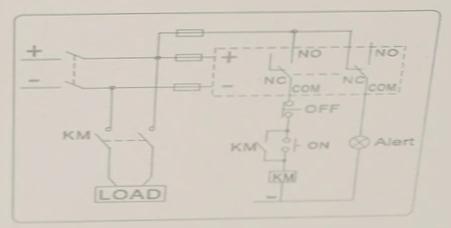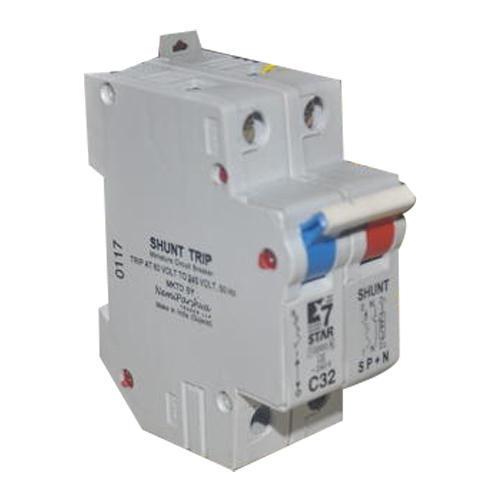
|

|
Forum Index : Electronics : Under and Over Volts Relay
| Author | Message | ||||
| Technophiliac Regular Member Joined: 18/12/2020 Location: New ZealandPosts: 92 |
Has anyone figured out how to wire an Under and Over Volts Relay? They look like a really cool bit of kit...if I can figure it out!  Ref https://www.aliexpress.com/item/4001352503214.html Davo, Wellington. You can have it perfect, on time, and at the best price. Choose any two. |
||||
| Murphy's friend Guru Joined: 04/10/2019 Location: AustraliaPosts: 648 |
All the info you need is on the schematic above, identify the terminal numbers from the pictures at the website. yYu need one external relay (KM) which has 3 x N/O contacts and wire it to the over/under relay as shown in your diagram. The contacts must be able to handle your load amperage. |
||||
| Warpspeed Guru Joined: 09/08/2007 Location: AustraliaPosts: 4406 |
KM could also be a double pole dc circuit breaker fitted with a shunt trip coil. That will then give you over and under voltage protection, over current protection, plus a convenient means of manual battery isolation.  Cheers, Tony. |
||||
| davef Guru Joined: 14/05/2006 Location: New ZealandPosts: 499 |
Why is the contact rating given as 6A 230V? I assume that is referring to the double pole switch on the left-hand side of the schematic. If that switch is internal to the device doesn't it have to handle load current as well as on break as well? |
||||
| Technophiliac Regular Member Joined: 18/12/2020 Location: New ZealandPosts: 92 |
I appreciate the replies, thanks. My interpretation was the two off two-way-relays were each rated at 6A 230V. I am not sure what KM stands for, anyone? The use I am considering is as the brains for a stepped dump load for a wind turbine using a 3 phase water heating element in an Oil Heater (same could be done for Hot water heating cylinder). In this case the relays would switch SCRs the current rating of the relays is largely irrelevant as the SCR's will do the heavy work. I am not sure the switching current for a SCR, I expect its measured in milliamps. Variations of the theme occur to me. Two of these units would allow no load as well until the turbine had spun up a bit. Thus in summary wind speed / voltage determines the dump load on the turbine for low, moderate and excess wind speeds. Davo, Wellington. You can have it perfect, on time, and at the best price. Choose any two. |
||||
| Warpspeed Guru Joined: 09/08/2007 Location: AustraliaPosts: 4406 |
I don't think that module will be suitable. You certainly do not want your dump load to switch in if the battery voltage ever gets down to the low (under voltage) set point. Just one or more voltage sensitive relays may be all you need. https://www.ebay.com.au/itm/DC12V-Auto-Circuit-Modifications-Voltage-Comparator-LM393N-Remote-Control-New/222087837604?hash=item33b57777a4:g:6R0AAOSwIGxcJKQt&frcectupt=true Edited 2020-12-29 08:24 by Warpspeed Cheers, Tony. |
||||
| Technophiliac Regular Member Joined: 18/12/2020 Location: New ZealandPosts: 92 |
Thanks Tony Your proposed comparator needs a reference voltage as well. The logic of the first scenario I had in mind (with some frame of reference juggling going on) was: 3 x 500W elements in 3 phase element. 1 x 500W element always connected. When voltage increases to become "normal" (moderate wind) the low voltage contacts will close switching in the 2nd element. When the voltage is "too high" the 3rd element will switch in. Because the relays are two way it seems to me they can be used either way. Where is the flaw in the logic that shows it will not work? David. Davo, Wellington. You can have it perfect, on time, and at the best price. Choose any two. |
||||
| Warpspeed Guru Joined: 09/08/2007 Location: AustraliaPosts: 4406 |
My reading of the notes is that the reference can either be external, or from the potentiometer on the board. Probably easiest to use a single external voltage setting potentiometer, and some fixed resistors to supply the slightly staggered references to each board. Why do you want to have a 500 watt load always connected ? The way I would do it would be to have all the loads switch in sequentially at around your maximum battery charging voltage. Suppose its a 12v system and you wish to charge up to 14.2v which is a common setting for automotive alternators. You might decide that one 500 watt dc load switches in at 14.2v, using a mosfet. One extra load switches in at 14.25v (making two loads) Two extra loads switch in at 14.3v (making four loads) Something like that perhaps. Cheers, Tony. |
||||
| Technophiliac Regular Member Joined: 18/12/2020 Location: New ZealandPosts: 92 |
I don't. It was just an example in working up the idea. Ideally there is no load until a minimum propellor speed is occurring. Interesting. What I had in mind was just a connected dump load and nothing else, until I decided what I would next do with it once I had some idea what I was actually getting from it. The way you suggest may well make for a very simple working system (!) once rectification is added. Balancing the load between not draining the battery while dumping excess power might be an issue, possibly solved with a strong diode? Accurate voltage settings required for that. Perhaps your proposed kit is accurate once set. A zener diode might be used to give the required reference voltage. Your proposal may well be cheaper to do than I thought of. I've not used mosfet's so not sure what current they will switch, which to select, or how much heat sinking is required. Switching 500W is a respectable load.... Davo, Wellington. You can have it perfect, on time, and at the best price. Choose any two. |
||||
| Warpspeed Guru Joined: 09/08/2007 Location: AustraliaPosts: 4406 |
The only purpose of having a dump load is to prevnt overcharging in strong wind, while keeping the turbine fully loaded to prevent uncontrolled overspeed. It does not matter if the load is ac or dc, but dc load is simpler and a lot easier to control, and its the battery voltage you need to be looking at to control the switching. You only need the one potentiometer to set all of the voltage thresholds together. The slight stepped voltage differences from that can all be done with some fixed resistors. Cheers, Tony. |
||||
| Technophiliac Regular Member Joined: 18/12/2020 Location: New ZealandPosts: 92 |
Hey Tony, appreciate your thoughts, thank you. For me its more than just a dump load. Where I live we get a rip roaring southerly wind which is cold (0 degrees).....I figured some direct heating from the wind might be a good use of that wind as well as controlling the overspeeds that will occur. (20 m/s gusts not out of the ordinary) Keeping it really simple I figured I did not even need a battery for that. But yes looking ahead it would be good to use the power for more than mere heating. FWIW converting DC to mains thru and inverter to fuel mains heaters (water and environs) strikes me as a path to a lower efficiency system in terms of energy conversion to heat where its wanted. Also reduces alternative heating costs. Anyway that's been part of my thinking. Hope that makes sense. Davo, Wellington. You can have it perfect, on time, and at the best price. Choose any two. |
||||
| Warpspeed Guru Joined: 09/08/2007 Location: AustraliaPosts: 4406 |
Yes that makes perfect sense. What you need to know is how much load your turbine can carry over various ranges of wind speed. You want to extract as much power (heat) as possible, but not apply so much load the blades stall and power falls off. The best way might be to have an anemometer to measure actual wind speed, and use the electrical output of that that to switch in various amounts of load appropriately. A power meter will tell you when switching more load in or out is helping things or not. Its a form of maximum power tracking, but it relies only on measured wind speed to determine the optimum turbine loading. Cheers, Tony. |
||||
| Technophiliac Regular Member Joined: 18/12/2020 Location: New ZealandPosts: 92 |
Mmmm I have been monitoring the wind for a number of months using several anenometers. One is an NRG unit with a Hall effect sensor added (which worked better to a logging arduino - (logging to usb). I'd been thinking I'd get the wind speed off the AC frequency, but as you point out varying loads will throw any hope of accuracy out the window (unless getting into supersophisticated setups - I note some controllers claim to read wind speed). I was trying to keep it simple and avoid use of computing power, but what you say makes sense - and opens the door to control scr's programatically via arduino as well. I guess you are going to say use a mosfet to fully vary the load to tune it optimally as the heater elements are very coarse steps. Power meter. Hmmm. Maybe an arduino could measure the voltage and amperage as well. The wind here is widely variable second to second so real time load adjustment is likely to keep things running efficiently. I guess the commercial units with their ceramic dump resisters will also vary their dump loads dynamically as well. I did think about substituting a commercial dump resister with the hot water element - assuming a resistance match is found. Has anyone done that? Davo, Wellington. You can have it perfect, on time, and at the best price. Choose any two. |
||||
| Warpspeed Guru Joined: 09/08/2007 Location: AustraliaPosts: 4406 |
Its an important feature to measure wind speed completely independently to what your turbine is doing with regard to turbine rpm. That will change with load, and you can end up chasing your tail and get surging and instability. Power meter is probably the very first step. You can do it yourself with an arduino, it only needs to measure relative power, if the power has increased or decreased when more load is switched in or out. Or you can buy a commercial dc power meter for less than thirty dollars, and have a ton of handy features. These are amazingly accurate with very fine resolution. I have a couple of these myself. https://www.ebay.com.au/itm/150A-Digital-LCD-Watt-Meter-Power-Analyser-Solar-Caravan-Anderson-Plug-Tool/232109268425?epid=23032791440&hash=item360aca5dc9:g:w0cAAOSwHVhdy4~c Then experiment with different loads at different wind speeds, to get some idea of what may be required to control the final beast. Cheers, Tony. |
||||
| BenandAmber Guru Joined: 16/02/2019 Location: United StatesPosts: 961 |
Even though it dont apply here have you guys seen the bucket of salt water resister oz made it is very cool be warned i am good parrot but Dumber than a box of rocks |
||||